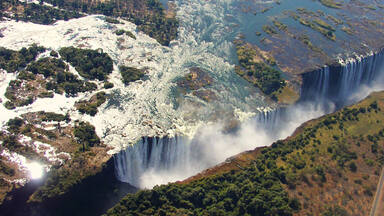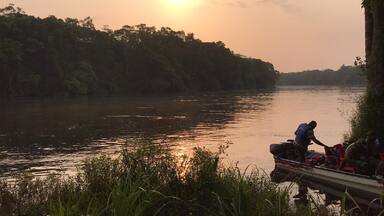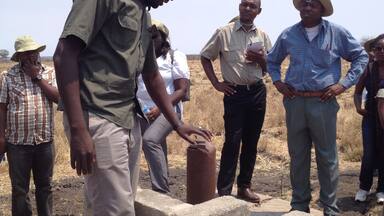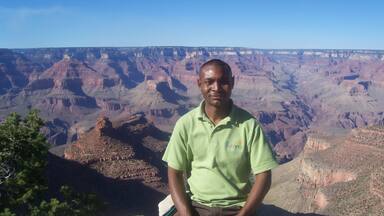Mosi-oa-Tunya / Victoria Falls
Mosi-oa-Tunya / Victoria Falls
These are among the most spectacular waterfalls in the world. The Zambezi River, which is more than 2 km wide at this point, plunges noisily down a series of basalt gorges and raises an iridescent mist that can be seen more than 20 km away.
Description is available under license CC-BY-SA IGO 3.0
Mosi-oa-Tunya / Chutes Victoria
Elles figurent parmi les chutes d'eau les plus spectaculaires du monde. Le Zambèze, large de plus de 2 km à cet endroit, s'engouffre bruyamment dans une série de gorges de basalte, provoquant une brume irisée visible à plus de 20 km de distance.
Description is available under license CC-BY-SA IGO 3.0
موزي أوتامبرا /شلالات فكتوريا
تعدّ هذه الشلالات الأروع في العالم، فشلال زامبيزي الذي يزيد عرضه على الكيلومترين في هذه النقطة يسقط هادراً في سلسلة من الفتحات المكوّنة من أحجار البازلت مخلفاً سحابة متقزحة بادية للعيان على بعد يفوق 20 كيلومتراً.
source: UNESCO/CPE
Description is available under license CC-BY-SA IGO 3.0
莫西奥图尼亚瀑布(维多利亚瀑布)
这是世界上最壮观的瀑布之一。赞比西河宽度超过2公里,瀑布奔入玄武岩峡谷,水雾形成的彩虹远隔20公里以外就能看到。
source: UNESCO/CPE
Description is available under license CC-BY-SA IGO 3.0
Моси-оа-Тунья/Водопад Виктория
Это один из самых великолепных водопадов мира. Он расположен на реке Замбези, ширина которой в данном месте превышает 2 км. Река с грохотом обрывается вниз в базальтовое ущелье, а облако водяных брызг можно видеть более чем за 20 км от водопада.
source: UNESCO/CPE
Description is available under license CC-BY-SA IGO 3.0
Mosi-oa-Tunya – Cataratas Victoria
Estas cataratas figuran entre las más espectaculares del planeta. El río Zambeze, que tiene más de dos kilómetros de ancho en este lugar, se precipita con estruendo por una serie de desfiladeros basálticos, levantando una nube de rocío iridiscente que puede verse a más de 20 kilómetros de distancia.
source: UNESCO/CPE
Description is available under license CC-BY-SA IGO 3.0
モシ・オ・トゥニャ/ヴィクトリアの滝
アフリカ南部のザンビアとジンバブエの国境を流れるザンベジ川の中流にある滝。幅約1700m、落差は最大150mにもなる滝から降りそそぐ水滴で潤う周辺の森林には、900種を越える植物や多くの野生動物が見られる。現地で「モシ・オ・トゥニャ(とどろく水けむり)」と呼ばれていた。1855年、探検家リビングストンはこの滝を見つけ、イギリス女王の名をつけて世界に紹介した。source: NFUAJ
Mosi-oa-Tunya / Victoria-watervallen
Deze watervallen gelden als enkele van de meest spectaculaire ter wereld. Hier stort de meer dan 2 kilometer brede Zambezi rivier zich luidruchtig naar beneden in een reeks basaltkloven. Hierdoor ontstaat een regenboogkleurige mist die van meer dan 20 kilometer afstand te zien is. De watervallen bevinden zich op 915 meter boven zeeniveau en zijn 1.708 meter breed en gemiddeld 100 meter diep. Per minuut valt er 500 miljoen liter naar beneden. Hierdoor vormen ze het grootse gordijn van vallend water wereldwijd. Binnen de watervalzone is er sprake van een rivier-‘regenwoud’ met als overheersende vegetatie Mopane-bos en daarnaast kleine gebieden van teak- en miombo-bos.
Source: unesco.nl
Outstanding Universal Value
Brief synthesis
The Mosi-oa-Tunya/Victoria Falls is the world’s greatest sheet of falling water and significant worldwide for its exceptional geological and geomorphological features and active land formation processes with outstanding beauty attributed to the falls i.e. the spray, mist and rainbows. This transboundary property extends over 6860 ha and comprises 3779 ha of the Mosi-oa-Tunya National Park (Zambia), 2340 ha of Victoria Falls National Park (Zimbabwe), 741 ha of the riverine strip of Zambezi National Park (Zimbabwe). A riverine strip of the Zambezi National Park extending 9 km west along the right bank of the Zambezi and islands in the river are all within the Park as far as Palm and Kandahar Islands, with the Victoria Falls being one of the major attractions. The waterfall stands at an altitude of about 915 m above mean sea level (a.m.s.l.) and spans to about 1708 m wide with an average depth of 100 m and the deepest point being 108 m. Sprays from this giant waterfall can be seen from a distance of 30 km from the Lusaka road, Zambia and 50 km from Bulawayo road, Zimbabwe. Basalts have been cut by a river system producing a series of eight spectacular gorges that serve as breeding sites for four species of endangered birds. The basalts of the Victoria Falls World Heritage property are layered unlike those of the Giants Causeway World Heritage site which are vertical and columnar.
Criterion (vii): The Mosi-oa-Tunya/Victoria Falls is the largest curtain of falling water in the world; it is 1708 m wide and with up to 500 million litres per minute descending at 61 m (Devil’s Cataract), 83 m (Main Falls), 99 m (Rainbow Falls), 98 m (Eastern Cataract). Eight spectacular gorges of igneous origin (i.e. comprising basalts) and several islands in the core zone serve as breeding sites for four endangered and migratory bird species, such as the Taita Falcon and Black Eagle. The riverine 'rainforest' within the waterfall splash zone is a fragile ecosystem of discontinuous forest on sandy alluvium, dependent upon maintenance of abundant water and high humidity resulting from the spray plume of about 500 m (at maximum height) that can be seen from a distance of 50 km and 30 km from Bulawayo and Lusaka roads respectively. A direct frontage viewing of the falls is possible from both Zambia and Zimbabwe.
Criterion (viii): The Mosi-oa-Tunya/Victoria Falls and associated eight steep sided gorges have been formed through the changing waterfall positions over a geological time scale. The gorges are an outstanding example of river capture and the erosive forces of the water still continue to sculpture the hard basalts. These gorges take a zigzag course of a distance of about 150 km along the Zambezi River below the falls. Seven previous waterfalls occupied the seven gorges below the present falls, and the Devil's Cataract in Zimbabwe is the starting point for cutting back to a new waterfall. In addition, an aerial view of the falls shows possible future waterfall positions. Upstream are a spectacular series of riverine islands formed during the ongoing geological and geomorphological processes. The property is characterized by banded basalt of ancient lava flow, Kalahari sandstones and chalcedony out of which stone artefacts of Homo habilis dating three million years, stone tools of the middle Stone Age and weapons, adornments and digging tools of the late Stone Age that indicate occupation by hunter-gatherers.
Integrity
The transboundary property extends over 6860 ha, which is considered relatively intact and adequately sized to maintain the diverse natural processes, functions and interactions including the waterfall, gorges, riverine ecosystem, breeding ground, habitat or landing base for migratory endangered bird species making it an Important Bird Area (IBA), lava flows, ancient stone artefacts and tools for hunter-gatherers. It comprises 3779 ha of the Mosi-oa-Tunya National Park (Zambia), 2340 ha of the Victoria Falls National Park (Zimbabwe), and 741 ha of the riverine strip of Zambezi National Park (Zimbabwe). The boundary includes areas of the Zambezi River upstream of the waterfall both in Zimbabwe and in Zambia. The remaining area of these protected areas is considered as the buffer zone on either side of the Zambezi River in Southern Zambia and north‐western Zimbabwe. The Mosi‐oa‐Tunya National Park boundary follows the left bank between the Sinde River and the Songwe Gorge, bounded in the North by Dambwa Forest Reserve and the Maramba Township. On the right bank, the Victoria Falls National Park is bounded by the river from 6 km above to 12 km below the falls and by the town of Victoria Falls on the West. Sprays from this giant waterfall can be seen from a distance of 30 km from the Lusaka road, Zambia and 50 km from Bulawayo road, Zimbabwe. The system is directly bordered by three protected areas which serve as buffering system.
Protection and management requirements
The property is protected under the National Heritage Conservation Act (1998) and the Zambia Wildlife Act on the Zambia part and the Zimbabwe Parks and Wildlife Act Cap. 20. 14 of 2008 (revised) on the Zimbabwean side. This principal legislation provides for legal protection of the resources within the property. The property has a well-defined and buffered boundary which requires clean demarcation. It has a Joint Integrated Management Plan (JIMP) prepared in a participatory manner, approved by the State Parties in November 2007 and being implemented in a participatory manner.
The Plan addresses specifically questions of transboundary coordination, management of urban and tourism facilities and funding schemes. It is divided into three administrative zones (High, Medium and Low Ecologically Sensitive Zones), each with specific prescriptions that best protect the specific resources and values found in each zone. These are surrounded by a buffer zone, and there is a challenge to ensure support for conservation within settlements in this area that pre-date the inscription of the property on the World Heritage List.
The agreed institutional framework for the management of the property is at three levels: Joint Ministerial, Joint Technical and Joint Site Management Committees.
The property requires continued maintenance and updating of its management plan, supported by adequate staffing and provision of financial resources.
The falls being a major attraction, urban infrastructure developments, tourism facilities and services may impact the property’s integrity and therefore need to be carefully managed not to compromise the exceptional beauty and Outstanding Universal Value of the property.
Effective and continued action is also required to tackle the current and potential impacts of alien species on the property.
Notes
- Property inscribed for both geological and ecological values under natural criterion N (ii) before 1994. Criterion N (i) [Operational Guidelines 2002] was added. For more details see Decision 30.COM 8D.1.
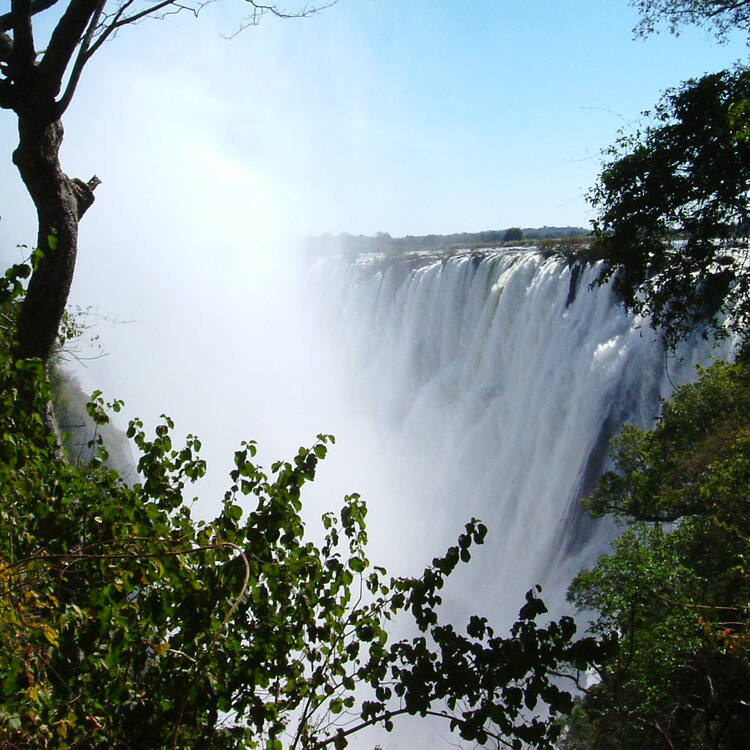
 View photos from OUR PLACE the World Heritage collection
View photos from OUR PLACE the World Heritage collection